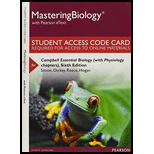
While walking in the woods, you encounter an unfamiliar flowering plant. Which of the following plant features would help you determine plant is a
- a. size of the plant
- b. number of seed leaves
- c. shape of its root system
- d. number of petals in its flowers
- e. arrangement of vascular bundles In Its stem
- f. whether or not it produces seed-bearing cones
To examine: Which plant features would help to determine whether that plant is a monocot or a eudicot.
Introduction: Angiosperms are that plants that have flowers and produce seeds that are enclosed within a carpel. The plants can be classified on the basis of structural difference into monocots and eudicots. The name of the embryonic structure of seed leaves is called cotyledons. A monocot has one seed leaf, whereas a eudicot has two seed leaves.
Answer to Problem 1SQ
Correct answer:
Option b. is given as “number of seed leaves”.
Option c. is given as “shape of the root system”.
Option d. is given as “number of petals in its flowers”.
Option e. is given as “arrangement of vascular bundles in its stem”.
Therefore, options b., option c., option d., and option e. are correct.
Explanation of Solution
Reasons for the correct statement:
Monocot has one cotyledon, fibrous root, flowers multiple of three, and vascular bundles are arranged complexly.
Eudicot has two cotyledons, taproot system, flowers usually multiple of four or five, and vascular bundles are arranged in a ring.
Hence, option b., option c., option d., and option e. are correct.
Reasons for the incorrect statement:
Option a. is given as “size of the plant”, but both monocot and eudicot have different sizes of plants. Hence, this cannot be used to differentiate between them.
So, option a. is incorrect.
Option f. is given as “whether or not it produces seed-bearing cones”, but seed-bearing cone is not a feature of monocot or eudicot.
So, option b. is incorrect.
Hence, options a. and f. are incorrect.
Want to see more full solutions like this?
Chapter 28 Solutions
Mastering Biology with Pearson eText -- Standalone Access Card -- for Campbell Essential Biology (with Physiology chapters) (6th Edition)
Additional Science Textbook Solutions
Laboratory Manual for Holes Human Anatomy & Physiology Fetal Pig Version
Human Biology: Concepts and Current Issues
Human Biology: Concepts and Current Issues (8th Edition)
Principles of Anatomy and Physiology
Genetics: From Genes to Genomes, 5th edition
- If you were given an unfamiliar vegetable, how could you tell if it was a root or a stem, based on its external features and a microscopic examination of its cross section?arrow_forwardwhich is common among a taproot system, circular arrangement of the vascular tissues, netted leaf veins, and a flower whose petals are in the multiples of four or five? a. Those are present to both monocotyledonous and dicotyledonous plant. b. Those are the external anatomy of an angiosperm. c. They are the distinguishing characterictics of a dicotyledonous plant d. Those are the main features of a monocotyledonous plant.arrow_forwardWhat is the function of the lenticels? Do all stems have lenticels? How can you differentiate a monocot plant from a dicot plant just by looking at the stem? What advantage would herbaceous stems have over woody stems?arrow_forward
- Angiosperms are the most diverse group of plants in existence today. Which of the following plant structures do angiosperms possess that are not found in any earlier lineage of plant? A. Fruits B. Seeds C. Pollenarrow_forwardIf you were asked to design a seed out of paper and tape that could be dispersed in the air, what features would you include and why? If the seed needed to be dispersed by water, what features would you include and why?arrow_forwardMany scientific words are also ordinary English words. If you read that a plant has a bulb or tuber, can you always be certain exactly what the botanical structure is?arrow_forward
- What are the differences between VASCULAR and NON-VASCULAR plants? What is the difference between a MONOCOT or a DICOT? How can you determine the difference between MONOCOTS and DICOTS?arrow_forwardAnswer the following question: How can you distinguish a monocot from a eudicot? How are insects such as bees important for the reproduction of angiosperms? What advantages do flowers give angiosperms over gymnosperms?arrow_forwardWhich of the following statements describes a difference between gymnosperms and angiosperms? a. Gymnosperms are nonvascular plants; angiosperms are vascular plants. b. Gymnosperms are seed-bearing vascular plants; angiosperms are seedless vascular plants. c. The seeds of gymnosperms are contained within a fruit; angiosperm seeds are "naked." d. Gymnosperms are seedless vascular plants; angiosperms are seed-bearing vascular plants. e. The seeds of gymnosperms are "naked"; angiosperm seeds are contained within a fruit.arrow_forward
- The following model is considered what root? Eudicot or Monocotarrow_forwardBougainvillea, Sunflower, and hibiscus are Perfect or imperfect? If imperfect, specific type of imperfect flower.arrow_forwardWhich of the following is NOT a function of the stem in a plant? Which of the following is NOT a function of the stem in a plant? A) absorb water B) store nutrients C) produce new plant cells D) support flowers and leavesarrow_forward
 Biology (MindTap Course List)BiologyISBN:9781337392938Author:Eldra Solomon, Charles Martin, Diana W. Martin, Linda R. BergPublisher:Cengage Learning
Biology (MindTap Course List)BiologyISBN:9781337392938Author:Eldra Solomon, Charles Martin, Diana W. Martin, Linda R. BergPublisher:Cengage Learning
